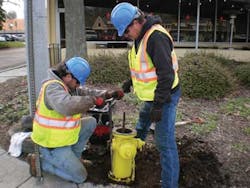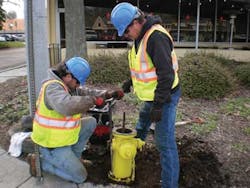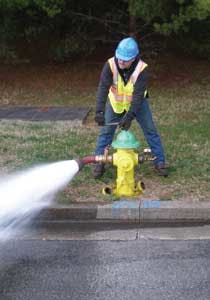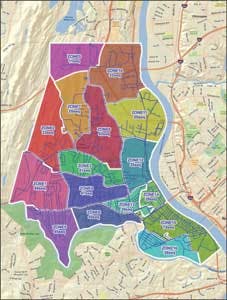Unidirectional Flushing: An Asset Management Program with Long-Term Benefits
By Dave Lewis
It's no secret that Unidirectional Flushing (UDF) is an excellent, water-efficient method of cleaning water distribution pipes to improve water quality and restore capacity. The premise is simple: develop a plan that flushes water from a clean source through a "dirty" pipe and out, working in one direction and one segment at a time. By cutting off other flows, scouring velocities of 5 to 10 ft/s or more are achieved, compared to 1 to 3 ft/s with conventional flushing. At these velocities, UDF scours out sediment, biofilm, corrosion products, and tuberculation. Not only is UDF a more effective way of cleaning than conventional flushing, but it uses on average about 40 percent less water than conventional flushing. Equally important, the sediment, corrosion products and biofilm are flushed out and not just moved to another pipe run that's often the case in conventional flushing.
What is not so well known is that UDF programs are essentially asset management programs that yield long-term benefits. What can you do to ensure the success of your UDF program and receive maximum benefit as an asset management program for years to come? Consider the following steps.
Step 1: Assess Your Assets
The key to a successful UDF program, like a good asset management program, is to assess your assets. These assets fall into two categories: business system assets, such as GIS mapping and hydraulic models; and physical assets in the pipes, valves and hydrants. The GIS and hydraulic model must be complete, accurate and integrated topologically for the UDF software to develop sequences that are functional. Without complete, accurate information, field crews executing the sequences will experience failures that range from inadequate system pressures and low flow conditions to incomplete flushing zones and nonsensical sequences that are actually isolations. In fact, if not done properly, UDF can actually make water quality worse by moving water just fast enough to stir up sediment, but not actually remove it.
Ensuring that your business system assets are complete and accurate not only helps develop a successful UDF program, but is essential to ongoing, effective asset management. This requires a complete physical asset inventory. The most efficient way to conduct the physical asset inventory is to combine it with physical asset assessment. Bottom line, your physical assets used in the UDF sequences have to work. This process involves three steps:
1. Consolidate the asset records. Pull together the as-builts, GIS data and institutional knowledge.
2. Evaluate assets in the field. Maximize this step by getting all the data you possibly can. Crews should assess asset condition, age and operability. Have crews identify mapping discrepancies, establish elevations and sub-foot GPS coordinates for each valve and hydrant. Mechanically test the asset. Operate the valves and flow-test the hydrants. Don't forget to assess the pipes to verify connectivity, type, size, and condition. Sample the water at key locations. Know how you will evaluate the success of your UDF program and sample with those parameters in mind. Is turbidity your main issue? Or is it chlorine residual, iron or manganese?
3. Update GIS and hydraulic models to reflect actual field conditions.
Step 2: Perform Criticality Analysis and Rehabilitate Assets
Based on Wachs Water Services experience, an average of 41 percent of water valves are inoperable. In West Springfield, the pre-flushing assessment found that 64 percent of valves were inoperable or inaccessible. If the field crew can't locate a required valve or a valve or hydrant is inoperable, the entire flushing operation comes to a halt. Had the flushing sequences been developed based only on as-built maps and GIS data, the UDF program would have encountered serious delays.
While UDF sequences can be designed around inoperable or inaccessible valves and fire hydrants, the majority need to be usable. They are the control points for water flow in the pipe network. Unusable control points are omitted in flushing plans.
Smaller flushing sequences are simpler and more effective. When valves can't be used to isolate the flow to a small flushing segment, the flushing segments become larger. Simulating isolations and flushing through modeling, with only usable assets, allows utilities to identify large isolations and excessively large flushing sequences. This helps determine which unusable valves are critical to repair or replace and which can remain unusable.
However, the benefits of determining workable isolation segments and assessing the size and criticality of these zones go far beyond the actual UDF flushing. In asset management, utilities consider the probability of successful repair and the criticality of an area when deciding between repairing a physical asset such as a valve, pipe or hydrant, and replacing it. By assessing how large an area must be included in an isolation segment, the criticality of that segment can be determined more accurately.
When an area is deemed critical and the impact of a failure would be significant, the cost of repair and the probability of repair success can be accurately balanced against the cost of replacement. Oftentimes repair or replacement of a key valve can significantly reduce the isolation area and minimize impact of a line break. The isolation mapping and modeling that are integral components of a UDF program are ideal for this type of asset management analysis.
Can you say with certainty which valves would, and more importantly, could be closed to isolate a line break in any given area? Do you know the extent of each isolation zone based on usable assets? Do you know which assets are the most critical for control of your system? The development of isolation segments required for a UDF program will give you that information.
Maximize the benefit by evaluating the criticality of your assets within the framework of an on-going asset management and capital improvement plan. The repairs and replacements made to make your UDF program more effective are usually the same ones that will increase serviceability in your system and reduce impacts and liability of line breaks in the future. The information alone will allow quicker response time and control of any system failure.
Step 3: Create UDF Plan, Maps
To prepare for a flushing program, the entire service area should be split into flushing zones and those zones subdivided into flushing sequences. Detailed maps are developed for each sequence, ensuring that the system is flushed with clean source water and that high flushing velocities are achieved.
Maximize the benefit by making sure the flushing maps include data collection. Identify the parameters that you want to evaluate to ascertain the success of your UDF program. Be sure to gather information on water quality both before and after flushing, as well as flows, pressure, flushing time, and system conditions.
Step 4: Execute the UDF Plan
Communication is the key to success in the implementation of a UDF plan. Use multiple methods to notify the public, with special emphasis on the areas that will be next in the flushing sequence. A website explaining the purpose of the flushing and a schedule is a critical component. A dedicated phone line with a live customer service representative dedicated to answering questions related to flushing is highly recommended. Be proactive in communicating the benefits of the flushing program prior to executing the program.
Harold Nantz, P.E., the Assistant Public Works and Utilities Director for Melbourne, Fla., stated that "the signs placed at the entrance to the flushing zones a few days prior to flushing were the most effective and least expensive method of public notification." Door hangers were manually placed in West Springfield a few days before the scheduled flushing and were very effective in minimizing customer concerns and complaints.
Maximize the benefit by ensuring that all data collection is done during the flushing sequences and is uploaded to the hydraulic model. John McClellan, P.E. consulting engineer with Tighe and Bond for West Springfield, stated that it is important to update the flow and pressure data obtained from the sequences as they are being done.
Step 5: Document Results and Capitalize on Asset Management Information
The benefit of a system-wide UDF program is immediately apparent in water quality and system service. Melbourne, Fla., saw the following results:
- Iron concentration reduced by 77 percent
- Chlorine residual up by 15 percent
- Turbidity decreased by 57 percent
But the most significant result: Customer complaints were reduced from a high of 1,300 per year in 2006 (over 2.5 percent of customers) to less than 100 per year following the UDF program. Nantz said Melbourne staff continue to use the UDF maps to flush sections in response to complaints.
In West Springfield, Mass., the results were equally impressive:
- Fire flows in M-17 testing showed increases in 66 percent of the locations tested.
- C factor was increased in 77 percent of the locations tested.
- Loss of chlorine residual was markedly reduced following the UDF flushing.
Jeff Auer of West Springfield points out another very important benefit of the UDF program: system evaluation and asset awareness. Staff there learned they had a number of closed valves in their transmission lines. He believes the reduction in closed valves has translated into "drastic reduction in water main breaks since 2008…going from 15 per year down to three." That's an 80 percent reduction. Equally important, accurate asset mapping allows them to know which valves can be used to control breaks that do occur, dramatically reducing the response time and liability.
About the Author: Dave Lewis is the Mid-Atlantic Senior Account Manager for Wachs Water Services. Lewis has more than 20 years of experience in the infrastructure mapping and GIS industry, leveraging his background in software development, photogrammetry, data conversion and GIS integration. He may be contacted at [email protected].
More WaterWorld Current Issue Articles
More WaterWorld Archives Issue Articles



